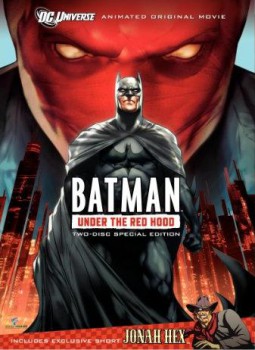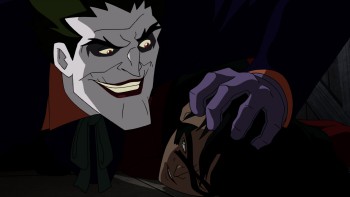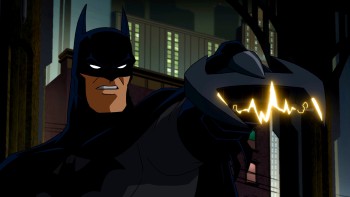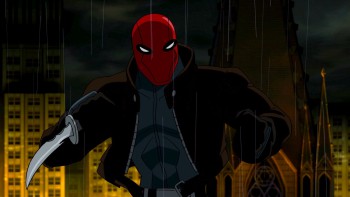Batman: Under the Red Hood
 Batman: Under the Red Hood (2010)
Batman: Under the Red Hood (2010)
Directed by Brandon Vietti. Featuring the Voices of Bruce Greenwood, Jensen Ackles, Neil Patrick Harris, John DiMaggio, Jason Isaacs, Wade Williams.
Warner Bros. Animation’s series of straight-to-video PG-13 releases set in the DC Comics universe has been a great success. Starting in 2007 with Superman: Doomsday (which completely embarrassed the previous year’s live-action Superman Returns) the team at Warner Bros. that originally kicked off the DC Animated Universe with Batman: The Animated Series has turned out high quality, adult-slanted fare that has even excited me about characters that I don’t usually care much about, like Wonder Woman and the Green Lantern.
But, no surprise, much of the new DVD series has featured Batman, the hottest property in Warner Brothers’ DC catalog because of the huge success of the Christopher Nolan-directed movies. Batman got his own compilation disc with Batman: Gotham Knight (set in the Nolan-verse and featuring a round-robin of top anime-directing talents), co-starred with Superman in Superman/Batman: Public Enemies (an adaptation of the Jeph Loeb-written arc in the popular Superman/Batman ongoing comic), and played a major part in Justice League: The New Frontier and Justice League: Crisis on Two Earths.
Now Batman has his second solo-starring release in the series. Based on a recent popular storyline in Batman’s eponymous comic book that tied into the mega-crossover event “Infinite Crisis,” Batman: Under the Red Hood brings PG-13 to the small screen in a big way. In fact, the film flirts with a “soft R” rating, and it’s definitely not for children—unless you don’t mind your children watching not one but two brutal beatings with a crowbar.
Yes, if you’re a Bat-fan, you know what I’m talking about: the (in)famous “A Death in the Family” storyline from 1988–89, where readers could vote by calling a 900-number (today they would just text their votes in) to decide whether the second Robin, Jason Todd, met his death at the hands of the crowbar-happy Joker. Readers either weren’t thrilled with Jason Todd, an admittedly prickly character, or else wanted to see if DC would really, you know, do it, and gave the gladiatorial “thumbs down.” DC stuck to their guns and crowbars and explosives, and goodbye Jason Todd.
“Under the Hood,” the original title of the comic arc and subsequent trade paperback, arriving on the heels of the massive gang war scenario of “War Games,” put the Jason Todd question at the forefront of Batman’s world once again and ended up making some major changes in Bruce Wayne’s life. It was a daring move for writer Judd Winick, and a roller-coaster ride if you were reading at the time, but it paid off as one of the most satisfying Batman stories in years. It was overshadowed only by a coincidentally similar story at Marvel in Captain America, writer Ed Brubaker’s “The Winter Soldier,” which may very well be the best thing either mainstream comics company has done in the last ten years. (I hope that Marvel either works that story into the coming Captain America: The First Avenger live-action movie, or produces a DVD feature animated film of it.)
The animated version of “Under the Hood” is one of the strongest yet in the DC Animated Original Movies line, second for me only to Superman: Doomsday. It has a number of flaws, none of them crippling however, and delivers on the promise of a dark Batman adventure with serious violence and heavy issues for the Caped Crusader to confront. It makes a nice parallel with the current ongoing animated TV series, Batman: The Brave and the Bold, which is definitely child-friendly and Silver Age in tone. Hey, who says you can’t have bleak Batman and day-glo technicolor Batman at the same time? You have to prep the children in some way so they can eventually watch The Dark Knight.
 Batman: Under the Red Hood opens with the PG-13 ferocity in full-force, re-enacting the finale of “A Death in the Family” in a streamlined fashion set in Serbia and with Ra’s Al Ghul involved. Once again, Batman is too late to save Jason Todd from a beating and subsequent explosion . . . then cut to five years later, when the underworld of Gotham has fallen under the sway of the crime boss the Black Mask. A new entity makes an appearance in the drug-dealing world, a masked figure of remarkable athletic and combat prowess who calls himself “The Red Hood.” He starts fearlessly wedging into Black Mask’s operation and annexing his lieutenants, and also demonstrates a rather, uhm, nihilistic attitude toward the drug dealers who work for him. Like decapitation.
Batman: Under the Red Hood opens with the PG-13 ferocity in full-force, re-enacting the finale of “A Death in the Family” in a streamlined fashion set in Serbia and with Ra’s Al Ghul involved. Once again, Batman is too late to save Jason Todd from a beating and subsequent explosion . . . then cut to five years later, when the underworld of Gotham has fallen under the sway of the crime boss the Black Mask. A new entity makes an appearance in the drug-dealing world, a masked figure of remarkable athletic and combat prowess who calls himself “The Red Hood.” He starts fearlessly wedging into Black Mask’s operation and annexing his lieutenants, and also demonstrates a rather, uhm, nihilistic attitude toward the drug dealers who work for him. Like decapitation.
After Batman and Nightwing witness the Hood murder some of his own operatives, the Dark Knight gets on the case of figuring out who the new loose cannon in Gotham is. The most immediate suspect on his mind is the Joker. The Joker used the Red Hood as an alias during the crime that dropped him into the chemical bath that transformed him into everybody’s favorite clown-white psychopath. However, the Joker is currently locked up Arkham Asylum, and as he explains face-to-face to Batman, this new Red Hood isn’t his M.O. “You really think I would stir up so much trouble and not make sure you knew it was me?”
Batman soon deduces the identity of the Red Hood, as will any audience member who didn’t already know it coming in from the comics. Combating the Red Hood’s increasingly PG-13 war on Black Mask’s organization (which includes the on-screen full immolation of a thug, multiple shooting deaths, and a blood-spattered wall as a cyber-assassin’s head explodes) puts Batman in contact with what he considers his greatest failure, the one that still haunts him, and also forces him to look at the consequences of his famous “no kill” policy.
From the visual viewpoint, Under the Red Hood looks superb—this is best animation I’ve see yet from the DC releases. The style appears about halfway between the Art Deco/Expressionist designs from Batman: The Animated Series and the Techy/Anime look of the recent series The Batman. It’s the closest any animated Batman has come to matching the stylistic appearance of the contemporary comics. The melding of the cell animation with CGI for the action sequences is beautiful, so that even though a viewer can tell a piece is CGI, it isn’t distracting at all but a useful tool to allow fast, full-motion action. A chase with the Batwing on the trail of an escaping car, and a later pursuit with Nightwing and Batman hurtling across rooftops and construction sites to nab the Red Hood are top-flight excitement. Even though made on smaller budget than a theatrical animated film, much of this would stand up well on a big screen. (For example of how wrong the CGI-and-Cel mix can go, see Dragonlance: Dragons of Autumn Twilight. Uhm, on second thought, don’t.)
Where Batman: Under the Red Hood lags somewhat is in a script from Judd Winick that veers between brilliant and clumsy. Part of this is simply that Winick has to work out a stand-alone tale from a intricate comic storyline that ties into a large amount of history and concurrent events. Winick’s solutions to streamline the plot do mostly work (I’m glad to have anything “Infinite Crisis”-related ditched, thanks) but they require some exposition-dumps where characters decide to blatantly explain who “so-and-so” is. For example, there are two thugs who decide they need to explain to each other—and the audience—that Nightwing is actually the first Robin and the Robin we saw die earlier is the second. This happens in the same scene where Batman explains to the same thugs exactly what the android “Amazo” is, even though he has no reason to educate stupid muscle-for-hire.
 And Amazo is symptomatic of another problem with the script: some of the heavier attempts at science-fiction elements don’t sit well with a noir gangster story. Amazo, who comes straight from the comic story, looks rather absurd in this setting, like an intruder from a Superman comic. The action scene with him is exciting, but also a bit early for such an out-there concept. The same applies to the four cyber-assassins who look too much like rejected characters from Batman Beyond. That the Black Mask, a very old-school style villain, is behind such weird super-science schemes may work fine in the greater DCU, but in a solo-Batman production it seems a bit off.
And Amazo is symptomatic of another problem with the script: some of the heavier attempts at science-fiction elements don’t sit well with a noir gangster story. Amazo, who comes straight from the comic story, looks rather absurd in this setting, like an intruder from a Superman comic. The action scene with him is exciting, but also a bit early for such an out-there concept. The same applies to the four cyber-assassins who look too much like rejected characters from Batman Beyond. That the Black Mask, a very old-school style villain, is behind such weird super-science schemes may work fine in the greater DCU, but in a solo-Batman production it seems a bit off.
However, Ra’s Al Ghul’s appearance, although brief, is an idea that Winick inserts seamlessly into the action. Although Ra’s Al Ghul brings a few overtly fantastic concepts into the story, there’s a wonderful smoothness and style to the character and his world that gels so well with Batman’s, and provides a nifty solution to the most difficult problem the original story offers in a stand-alone production. I honestly believe that Ra’s Al Ghul makes everything better just by showing up for a few minutes.
When Winick’s script is on . . . it’s explosive. The places where he discards exposition for well-timed flashbacks are often very moving. The writing in the finale is superb, relying not so much on the action (we’ve had plenty up to this point) but the conflict of ideals and the build of five years of rage. The movie puts forward the same challenge to Batman that the comic series did: Just when does your “no kill” policy actually become dangerous to innocent people? Specifically, why is the Joker still alive when you know he will escape again and murder more innocents? And wasn’t Jason Todd’s death enough to warrant permanently ending the Joker’s killing sprees?
Batman has an answer for this . . . and although it’s a good answer that most of us could agree with in concept, it still isn’t quite enough. It can’t be, and that’s why I think this is such superb drama. Batman himself knows the answer is shaky, and that any answer has frightening implications. Batman: Under the Red Hood delivers on its dramatic promise in a way that the comic couldn’t quite achieve—because the comic has to continue, while the movie is allowed to stop and leave you with the questions.
The voiceover work ranges from very good to middling. Bruce Greenwood as Batman sounds like he’s doing a dead-on impersonation of Kevin Conroy, the most famous of animated Bat-voices, and I expected something a bit different from an actor as skilled as Greenwood. Neil Patrick Harris has a nice youthful swagger as Nightwing, although again it seems as if any regular voiceover performer could have done the same. John DiMaggio is a disappointment as the Joker; there’s a raft of great Joker performances to live up to, and DiMaggio simply plays Joker with a suave voice and a touch of grit, and it doesn’t match the meaty and crazy design on the screen.
 On the positive side is Jensen Ackles as the Red Hood. When he first appears, he seems to be underplaying the part, but as the story progresses there appears a definite pattern to Ackles ratcheting up the character until the finale with Batman, where he utterly nails the great material the script gives him.
On the positive side is Jensen Ackles as the Red Hood. When he first appears, he seems to be underplaying the part, but as the story progresses there appears a definite pattern to Ackles ratcheting up the character until the finale with Batman, where he utterly nails the great material the script gives him.
Wade Williams certainly has a good time playing the anger-management impaired Black Mask, a near-psychotic mob boss who looks like the Red Skull (only, uhm, black) dressed in a leisure suit. Despite Williams’s undeniable energy tackling the voice part, the Black Mask comes across as a much less effective villain than the “Boss of Bosses” from the comic books. (“I like you, Scarecrow. You’re my kind of twisted.”) This is partially because the Black Mask has to stay in the shadow of the lethally effective Red Hood, the maniacal Joker, and Ra’s Al Ghul, who even in a small role seems like he could take over the world with a snap of his fingers. Black Mask does get my personal favorite line in movie, when he’s ranting about the need to knock-off the Red Hood: “When he shows up to shut us down, have a party waiting for him. And when I say ‘party,’ I actually mean a whoooole lot of people who are going to kill him!” This isn’t as good as my favorite “off ‘em” mob line, from the TV show Sledge Hammer!: “I want this Sledge Hammer, for the rest of his life, to be dead!” But it shows the same spirit.
Of the straight-to-video Batman animated films, Under the Red Hood rests a bit under Batman Beyond: The Return of the Joker (unrated version) in quality. For Batman fans and comics fans in general, it’s a must-see and probably a must-own; it’s easiest for people in these groups—and I belong to both—to coast over the flaws, and repeat viewings are a guarantee. More general viewers might have some trouble with the few clunky, out-there sections—such as Amazo—but it’s definitely rental-worthy; given the pattern of DCAU films on Netflix, it will probably be available on Instant Viewing in a few months.
But again: not for the little kids. Crowbar, crowbar, crowbar. Splat . . . red wall.
Be on the look out, in 2011, for an animated adaptation of the seminal Batman “origin” comic: Batman: Year One.
hey, I’ve got a question for you, do you remember episode Bane in the original Batman animated series?